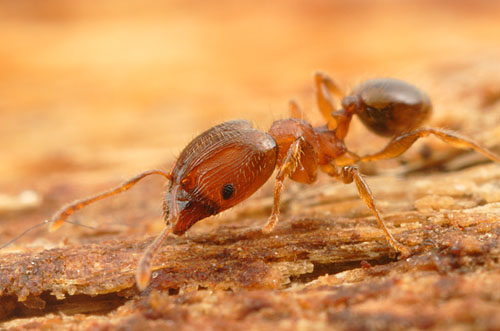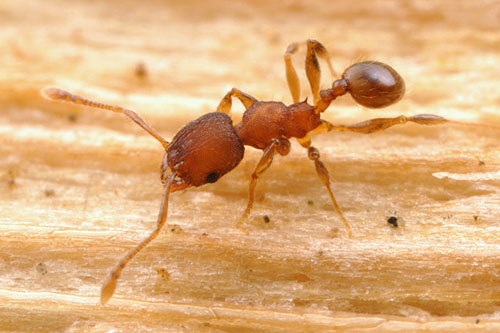
Pheidole moerens, major worker, Louisiana
Pheidole moerens is a small, barely noticeable insect that travels about with human commerce, arriving without announcement and slipping quietly into the leaf litter and potted plants about town.  As introduced ants go, P. moerens is timid and innocuous- it's certainly no fire ant. The species is now present in the southeastern United States, a few places along the west coast, and Hawaii. Conventional wisdom suggests that P. moerens originated in the Greater Antilles, but even though the ant was first described from Puerto Rico a century ago its exact origin remains uncertain.
The Greater Antilles were a major hub in the global trade of the colonial era, receiving slaves from Africa and shipping sugar north to the distilleries. A great number of pests had already been carried to the islands by the time European scientists started to fully describe the fauna, so it's not unlikely that many animals considered native there may have merely used the archipelago as a way-station between their actual origin and their ultimate global distribution.
Now that scientists are equiped with the tools of molecular genetics, we have the ability to determine more precisely the historical routes of spread. It would not take too much work to pin down the origin of P. moerens. But this ant is just one species of many that are both globally trampy and not particularly troublesome. Elucidating its origin is thus more an academic than an applied matter, so Pheidole moerens will likely remain mysterious for some time yet.

Pheidole moerens, minor worker, Louisiana
photo details: Canon MP-E 65mm 1-5x macro lens on a Canon EOS 20D
ISO 100, 1/250 sec, f/13, flash diffused through tracing paper
- Log in to post comments


Thanks for the presentation of this species. I have collected a Pheidole species on plants inside our building here at NCSU but never really took time to identify them. i only took some pictures (http://www4.ncsu.edu/~bsguenar/Pics%20Pheidole%20Sp%201%20North%20Carol…).
But thanks to your article today, I think I might have found what they are.
Cool!
Thanks.
Really enjoy your blog (I visit it mostly every day)
P. moerens would also be an excellent candidate for further study as, unlike many invasives I've encountered, it is one of the few that readily invades any natural or man-made habitat. I also suspect that more recently, like P. obscurithorax, it is really starting to take off in both local abundance and increasing range.
Good post, I say!
Biogeography is always interesting and the mystery of occurrence is a great detective novel. Great article!
Very interesting
A pretty good-looking little Pheidole indeed. The major's head is not as disproportionately enlarged as in many other species of this huge genus.
I ignored that some Pheidole species had antennal sulci like this one, albeit shallow. This reminds a bit of Wasmannia. The more you know about Myrmicine Ants, the more you discover this structure is widespread throughout the subfamily.